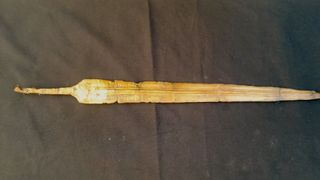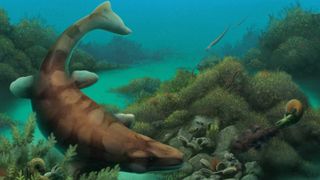We rarely get the chance to sing a classic David Bowie song while reading the latest science news, but this week we saw the return of the Mars spiders. No, they are not true arachnids roaming the surface of the Red Planet – instead they are part of a geological formation known as the araneiform zone. These dark, crack-like structures are formed when carbon dioxide periodically erupts from the earth’s surface and look like spider webs when viewed from above. And now, the first time they are recreated on Earth.
But these “spiders” are not the only thing we have to keep an eye on in space: There are new ‘mini-moon’ short orbits around our planet; to be discovered that the Earth would have once worn a ring like Saturn; and site waste management leading us to the intelligent aliens.
A 3,200-year-old ancient Egyptian chamber contains a sword inscribed ‘Ramesses II’.

Recently, archaeologists in Egypt have unearthed the remains of a 3,200-year-old military building that contained a sword with inscriptions. showing the name of Ramesses II.
Remains of pots containing fish bones were found in the area, as well as many cattle graves.
A bronze sword was found in a small barracks, near a poorly protected area where the enemy could enter. This is an indication that this sword was meant for fighting and not just for show, Ahmed El Kharadlyan archaeologist with Egypt’s Department of Tourism and Antiquities who led the excavation at the site, told Live Science via email.
Find out more about classical education
–Rare bones up to 30,000 years old reveal when ancient humans entered puberty.
–Man buried with large rocks in chest to prevent him from ‘rising from grave’ unearthed in Germany
Why do we forget things we’ve been thinking about?

Have you ever walked into a room and forgotten why you were there, or want to speak but suddenly realize you don’t know what to say? The human brain usually balances many inputs, thoughts and actions, but sometimes, it seems short-sighted. So what actually happens when we forget what we were thinking about?
An 80-million-year-old sea monster’s jaws are packed with giant teeth in a frenzy for crushing prey found in Texas.

Fragments of a mosasaur’s fossilized jaw still holding white mushroom-shaped teeth.
Two pieces of fossils, discovered in Texas, give us a glimpse of the way of life of Globidens alabamaensiswhich may have been up to 20 feet (6 meters) long. The teeth show the brute force mosasaurs brought to carry their prey.
“These structures… are good for impact attacks – for breaking shells. If something escapes and you break it, that’s kind of it,” Bethany Burke Franklinmarine paleontologist and professor at the Texas Through Time museum in Hillsboro who was not involved in the study, told Live Science.
Find out more about animals
–Ocean Photograph of the Year 2024: See amazing photos of a hungry whale, walruses, rare baby fish, a patriotic eel and a beautiful venomous octopus.
–‘All it takes is a beast to learn that children are easy prey’: Why India’s ‘wolf’ attacks may not be what they seem
Also in science this week
Science Spotlight: 3 bold ways cities are already adapting to climate change

Milan’s marble floors and narrow cobbled streets look beautiful and timeless. But all that stone radiates heat and does nothing to absorb rain, and heat and flooding in the beautiful Italian city are predicted to increase in the coming decades.
In Jakarta, black floods are already entering homes every winter along many rivers in the Indonesian city. The water is full of sewage and disease, but many people do not have the money to move. Soon, climate change will put most of Jakarta – and many other low-lying cities – below sea level.
And in dry San Diego, water is now considered a precious commodity. As droughts increase in the coming years, protecting this resource will become even more important.
Human-caused climate change is altering climate and changing environmental conditions around the world. Cities will have to respond, and some are already taking bold steps.
Each of these three cities provides a cross-climate adaptation map with lessons for other places around the world. And while no single approach will be a silver bullet, each offers a hopeful vision of how we can learn to live and thrive in a warming world.
Something for the weekend
If you’re looking for something longer to read over the weekend, here are some of the longest reads, book excerpts, and interviews published this week.
Science in pictures: Mysterious waves ‘create life on their own’
It shows amazing microscopic pictures “waves” inside the fertilized fly won the 14th annual Nikon Small World in Motion competition.
Bruno Vellutini’s name video was chosen from among 370 entries as the overall winner of the contest on Tuesday (Sept. 17).
He captured the film by using light sheet microscopy, a method in which a focused “sheet” of laser light illuminates a sample to produce high-resolution 3D images of living cells, tissues and organisms.
Looking for more science content? Follow us Live Science WhatsApp Channel for the latest discoveries as they happen. It’s the best way to have our experts report on the go, but if you don’t use WhatsApp we’re here too. Facebook, X (formerly Twitter), Flipboard, Instagram, TikTok and LinkedIn.
#Science #news #week #Spiders #Mars #ancient #Egyptian #sword


